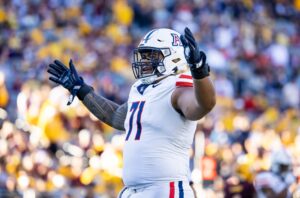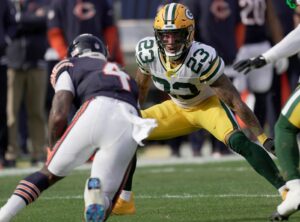Continuing our newest series, we take a deep dive at what the Buffalo Bills like to do on both sides of the ball.
The Breakdown: A Look at the Buffalo Bills Schematic Philosophy
The West Coast
New head coach Sean McDermott brings in Rick Dennison to coordinate his offense, who looks to install the West Coast system that he spent 13 years executing under Mike Shanahan when the latter was the head coach of the Denver Broncos.
At the core of the West Coast are multiple formations and personnel groupings that look to establish the run game first with an emphasis on efficiency in the passing game. The zone running game is a staple of this offense and fits running back LeSean McCoy like a glove, allowing him to capitalize on his short-area change of direction skills, sink-and-cut quickness and improvisational capabilities. This run scheme’s foundation is built on linemen blocking a “zone” rather than a specified defender as they all move in one direction, which in turn allows for multiple points of entry.
No team lined up in 21 personnel more often than Buffalo did this past season and they understood how to utilize tight ends Charles Clay and Nick O’Leary as H-Backs or wings to gain both gap and leverage advantages. This explains why the Bills agreed to a four-year/$8.4 million contract to former Falcons fullback Patrick DiMarco, widely regarded as the game’s top lead blocker. He played a pivotal role in Atlanta’s success on the ground last season and looks to have an immeasurable impact on the NFL’s top rushing offense in 2016.
What further adds to their success on the ground is the diversity that continually finds ways to get the defense out of position. With McCoy and speedy quarterback Tyrod Taylor, the Bills have implemented the use of a triple option that creates an offensive advantage by leaving one less defender to block and establishing an ever-changing point-of-attack. They like to marry this concept with counter, power and zone looks that force the defenders to respect their reads and run fits, while the occasional use of pre-snap motion to add the third option forces the defense to account for another moving gap on the fly. Defenses struggle to keep contain and win the gap advantage when they are out-schemed in this fashion.
In regards to the passing game, the West Coast is fundamentally structured around ball control and high-percentage throws with drops predicated on timing and rhythm that mirror the Hi-Lo concepts run out of multi-receiver sets that work to simplify the quarterback’s reads. Taylor is an efficient processor that works through the plethora of three-man combos on schedule while the horizontal stretches play well into the Bills’ personnel. So don’t be surprised to see rookie receiver Zay Jones play an active role in their passing game.
Further, the Bills did a great job incorporating rollouts, naked bootlegs and move-the-pocket throws that capitalized on Taylor’s ability to throw on the move and give him the option to tuck-and-run when necessary. Look for DiMarco to play a pivotal role here as well with his ability to leak out into the flat and serve as an underneath catch-and-run asset. This is where the Bills liked to stretch vertically and allow stud receiver Sammy Watkins to rely on his route running skills to out-leverage defenders down the field.
Flipping the Field
With McDermott taking over the defensive reins, Bills fans can expect a shift to the 4-3 with plenty of zone behind it. He coordinated the vaunted Panthers defense that finished 11th, third, 15th, second, and tenth in Football Outsiders’ DVOA measurement of efficiency between 2012-2016 with a league leading 24 interceptions in 2015 and the second most this past season (17).
This new front will likely suit the front seven more appropriately than the previous system that asked their slasher-skill set down linemen to occupy two gaps. Marcell Dareus and Kyle Williams are the disruptive interior defenders that McDermott prefers, turning them loose on passing downs and tasking them with fracturing the middle of the pocket to generate pressure and opportunities for his edge rushers to get home. In addition to keeping their linebackers clean, these interior defenders were largely responsible for forcing turnovers in Carolina as quarterbacks were forced to pull the trigger sooner-than-desired to avoid taking sacks. As for his defensive ends, McDermott prefers wide nine alignments that allow them to run the arc and bend the edge as tackles are forced to counter with positioning. Expect Shaq Lawson and Jerry Hughes to find statistical success. Ultimately, the basis of McDermott’s system is to generate pressure that leads to turnovers.
As previously mentioned, McDermott’s base coverage is your standard zone that pairs nicely with that pressure-filled defensive line. When quarterbacks are forced to expedite throws independent of the concepts’ rhythm, they end up throwing into the zones that the defense is taking away. Cover 3 is the base look much like it was in Carolina, but his use of Cover 2 and Cover 4 allows for pre-snap disguises and rolls to Robber looks which bleeds into the importance of run support from his defensive backs. Playing a two-high shell in a 4-3 will naturally spill runs to the perimeter while corners in Cover 2 are specifically tasked with pressing and working underneath, meaning they’re at a reasonable depth to come up and make a stop. As for McDermott’s safeties, they are run defenders first in Cover 4 and operating in a Robber role automatically puts them closer to the line and thus in position to shut down runs between the tackles. Corners in a zone scheme don’t carry the same value they would in man (just ask former McDermott corner Josh Norman, but a player who can legitimately play along the perimeter and in the slot like Tre’Davious White-or so they believe-is relatively uncommon in today’s NFL and worthy of a first round pick.
Lastly, McDermott places a host of responsibilities on his linebackers, and it’s easy to see why when you have the likes of Luke Kuechly and Thomas Davis whom he had in Carolina. He employs the use of the Double-A-Gap blitz in which two linebackers hover above both A gaps and fire through them on the snap, whether it be on a linear path or with a twist. These ‘backers have to be reactive and forceful in their path to the quarterback, requirements that their MIKE Reggie Ragland and SAM Lorenzo Alexander both meet. Such hefty duties carry over to their tasks in coverage where they have to be adept at recognizing the proper depth and landmarks when executing their zone drops; underneath zone coverage is vital for linebackers in this scheme. They also need to be active sideline-to-sideline players with an understanding of how to leverage runs along the perimeter. Luckily, that was one of Ragland’s best strengths at Alabama and he flashed the ability to replicate such skill as a rookie.






